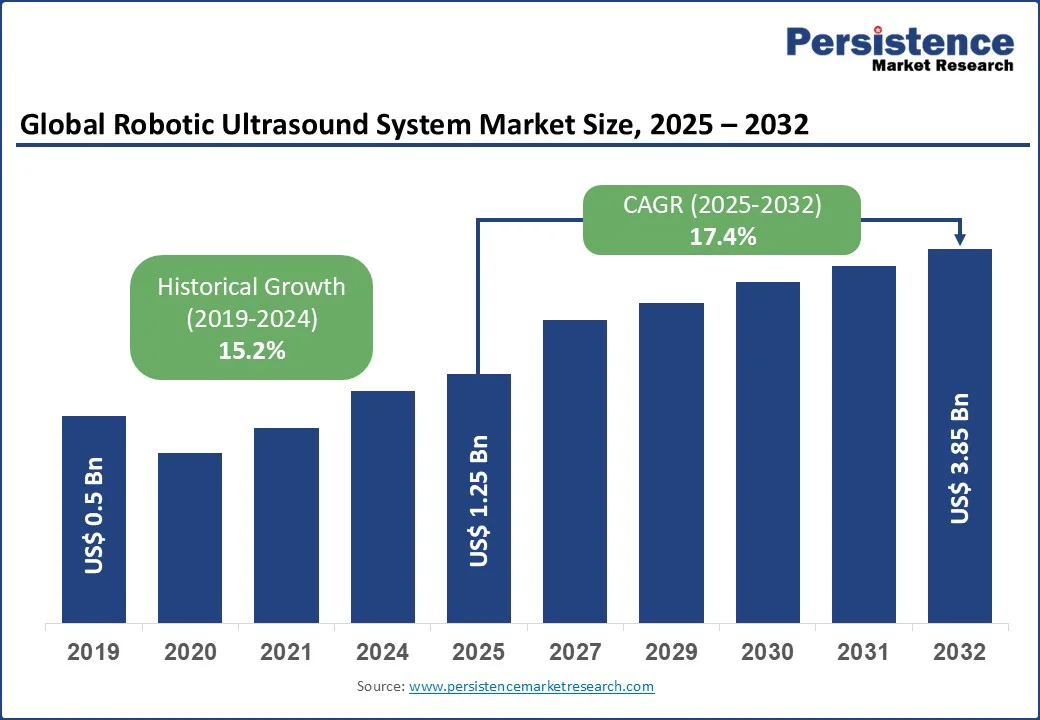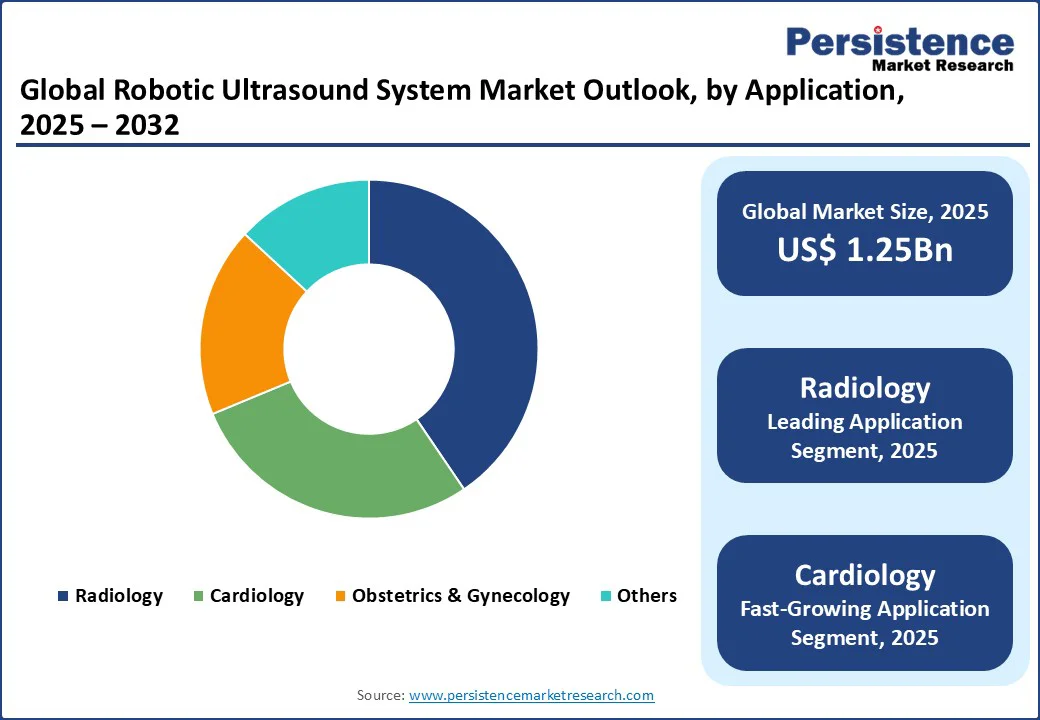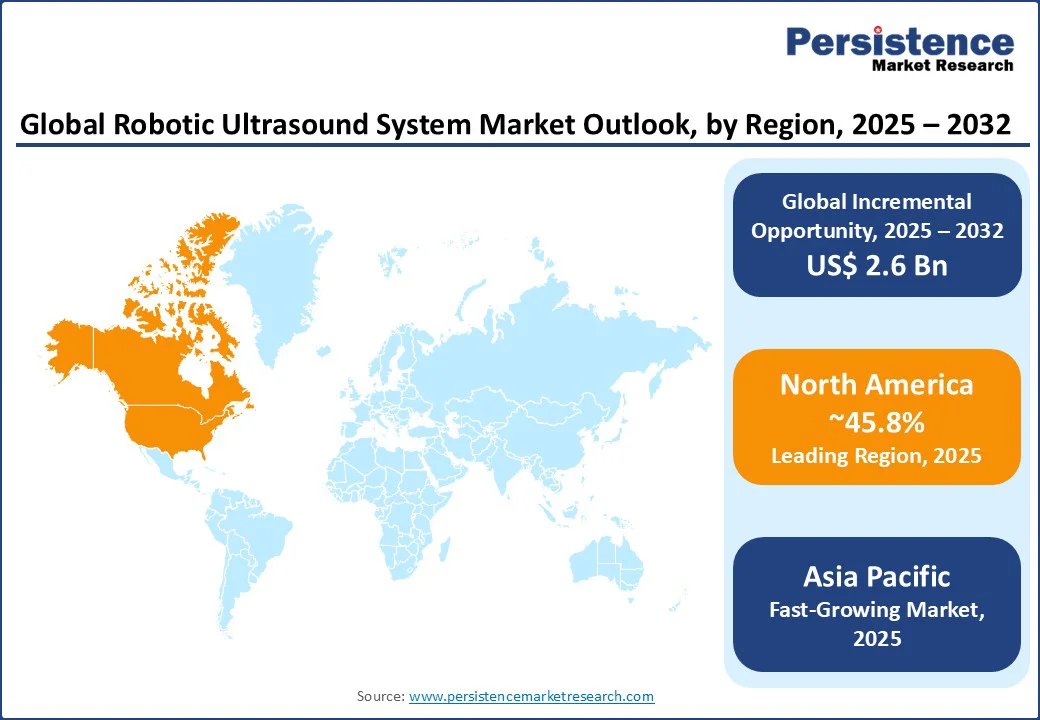ID: PMRREP27517| 185 Pages | 29 Aug 2025 | Format: PDF, Excel, PPT* | Healthcare

The global robotic ultrasound system market size is likely to be valued at US$ 1.25 Bn in 2025 and reach US$ 3.85 Bn by 2032, growing at a CAGR of 17.4% during the forecast period from 2025 to 2032.
The robotic ultrasound system market is experiencing rapid growth, driven by advancements in automation, artificial intelligence (AI), and increasing demand for precise, non-invasive diagnostic tools across healthcare settings.
Robotic ultrasound systems, known for their precision, reproducibility, and ability to reduce operator dependency, are critical for applications in radiology, cardiology, and obstetrics. The rise in chronic diseases, coupled with technological innovations in imaging, supports market expansion.
Key Industry Highlights

|
Global Market Attribute |
Key Insights |
|
Robotic Ultrasound System Market Size (2025E) |
US$ 1.25 Bn |
|
Market Value Forecast (2032F) |
US$ 3.85 Bn |
|
Projected Growth (CAGR 2025 to 2032) |
17.4% |
|
Historical Market Growth (CAGR 2019 to 2024) |
15.2% |
The robotic ultrasound system market is witnessing significant growth due to advancements in AI and robotics, which enhance diagnostic precision and efficiency. AI-integrated systems enable automated image analysis, real-time guidance, and standardized scanning protocols, reducing human error and improving reproducibility.
According to the World Health Organization, noncommunicable diseases (NCDs), such as cardiovascular diseases, cancer, diabetes, and chronic respiratory diseases, are responsible for 74% of all deaths worldwide, driving demand for accurate diagnostic tools.
In North America, companies such as GE Healthcare and Siemens Healthineers reported an increase in sales of AI-enabled ultrasound systems in 2024. In the Asia Pacific, China’s focus on smart hospitals and Japan’s advancements in robotic imaging fuel market growth. These technological innovations, coupled with rising demand for non-invasive diagnostics, ensure sustained market expansion through 2032.
The robotic ultrasound system market faces challenges due to high costs and limited accessibility in developing regions. The development and deployment of robotic systems require significant investment in advanced technologies, such as AI and robotic arms, leading to high equipment costs. In 2023, the average cost of a robotic ultrasound system ranged from $100,000 to $500,000, posing a barrier for smaller healthcare facilities.
Price volatility of components, such as semiconductors, further impacts production costs. Additionally, competition from traditional ultrasound systems, which are more affordable, limits adoption in cost-sensitive markets. Regulatory complexities and a lack of trained technicians in regions such as Latin America and Africa hinder market penetration, restraining overall growth despite technological advancements.
The increasing focus on telemedicine and remote diagnostics presents significant opportunities for the robotic ultrasound system market. Robotic systems enable remote imaging through tele-ultrasound capabilities, addressing healthcare access challenges in rural and underserved areas.
In North America, companies such as Philips and Esaote are innovating with tele-ultrasound solutions for rural clinics. Government initiatives, such as the EU’s Digital Health Strategy, promote remote diagnostics, creating opportunities for manufacturers to develop compact, AI-driven systems.
The rising prevalence of chronic diseases and the need for real-time diagnostics in emergency settings further drive demand for robotic ultrasound systems, positioning them as a critical tool for healthcare modernization through 2032.

North America dominates the robotic ultrasound system market, accounting for 45.8% of the market share, driven by advanced healthcare infrastructure and high adoption of AI-driven diagnostics in the U.S. and Canada. The U.S. healthcare sector relies on robotic systems for precise imaging.
Canada’s focus on telemedicine drives demand for compact systems, per Health Canada reports. Major players such as GE Healthcare and Philips dominate with extensive distribution networks, catering to hospitals and specialty clinics.
Government investments, such as the $47.35 billion NIH funding for AI in healthcare, ensure sustained market growth through 2032. A significant portion of this funding supports various research programs, including those focused on AI and healthcare innovation.
Asia Pacific is the fastest-growing region, fueled by rising healthcare investments and the increasing prevalence of chronic diseases in China and India. China, a leader in smart hospital initiatives, contributes significantly to market growth, per the China Health Commission.
India’s healthcare sector, supported by initiatives such as Ayushman Bharat, boosts demand for robotic systems. The region’s growing medical tourism and expanding diagnostic centers drive adoption, with companies such as Mindray and Fujifilm Holdings expanding their presence. Technological advancements and government-led digital health initiatives ensure the Asia Pacific’s rapid market growth through 2032.
Europe is the second fastest-growing region, driven by stringent regulations, rising demand in cardiology and radiology, and healthcare modernization in countries such as Germany and France. The European healthcare industry is a substantial sector within the EU, with healthcare expenditure averaging €3,685 per person in 2022, supporting demand for robotic ultrasound systems.
Germany’s focus on precision diagnostics and France’s investments in telemedicine fuel adoption. The EU’s Digital Health Strategy promotes AI-driven diagnostics, increasing demand for advanced systems. Companies such as Siemens Healthineers and Esaote innovate to meet regulatory and consumer demands, driving market growth through 2032.

The global robotic ultrasound system market is highly competitive and fragmented, with numerous domestic and international players ranging from large corporations to regional manufacturers.
Leading companies such as GE Healthcare, Siemens AG, and Koninklijke Philips dominate through extensive product portfolios and global distribution networks. Regional players such as Mindray focus on cost-effective solutions in the Asia Pacific. Companies are investing in AI, robotics, and tele-ultrasound technologies to enhance market share, driven by demand for precise diagnostics in radiology and cardiology.
The Robotic Ultrasound System market is projected to reach US$ 1.25 Bn in 2025.
Advancements in AI and robotics, along with rising demand for non-invasive diagnostics, are the key market drivers.
The Robotic Ultrasound System market is poised to witness a CAGR of 17.4% from 2025 to 2032.
The rising demand for telemedicine and remote diagnostics is the key market opportunity.
GE Healthcare, Siemens AG, Koninklijke Philips, and Fujifilm Holdings are key market players.
|
Report Attribute |
Details |
|
Historical Data/Actuals |
2019 - 2024 |
|
Forecast Period |
2025 - 2032 |
|
Market Analysis Units |
Value: US$ Bn/Mn, Volume: As Applicable |
|
Geographical Coverage |
|
|
Segmental Coverage |
|
|
Competitive Analysis |
|
|
Report Highlights |
|
|
Customization and Pricing |
Available upon request |
By Product Type
By Application
By End-use
By Region
Delivery Timelines
For more information on this report and its delivery timelines please get in touch with our sales team.
About Author